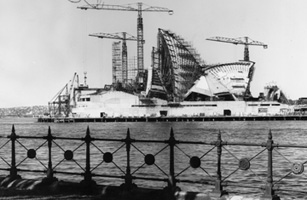
The Sydney Opera House, shown here in 1963, takes shape
Apart from a few keen pre-war readers who ordered TIME directly from the U.S., Australians and New Zealanders got their first look at the magazine you hold in your hands during World War II. As was the case in Europe and Asia, TIME printed cut-down editions to carry news to U.S. troops stationed in the Pacific. Over-the-shoulder reading fueled interest among locals, and at the end of the war, Henry Luce, TIME's co-founder, decided to sell TIME around the world. The edition for this region was initially printed in Tokyo and shipped south where it would arrive days later. But 50 years ago this month, TIME began printing in Melbourne, cutting delivery times and the cost of a subscription.
TIME quickly became a favorite way of discerning "what the world out there thought about Australia and New Zealand," says former correspondent John Dunn, who began reporting for the magazine in the late 1960s. TIME's reputation, he says, made his job easier, "because so many doors opened at the first mention of TIME."
To mark the 50th anniversary of our publication in the South Pacific, we take a look back at some of the people who have been at the forefront of dynamic change in the region — change that has seen homogeneous societies become multicultural, closed economies open up, and local artists and sports personalities win and burnish worldwide reputations. In charge of planning and editing the issue was senior editor Simon Robinson, a native of Melbourne, raised in Sydney, where he joined TIME in 1995. In a stellar career with us, Simon has also been based in Auckland, Nairobi, Johannesburg, Baghdad, New Delhi and now London. The Australians and New Zealanders he's met in his worldwide postings, he says, have made him aware of how the two countries punch above their weight.
May Wong, associate art director, based in Hong Kong, put in countless hours on the design of the issue, while Emily Thomas acted as picture editor and Vanessa Harriss saw the pages through our copy desk. I'm enormously grateful to them and all who worked on the issue for all of their time and creativity.
It has been an extraordinary 50 years in the South Pacific, and we trust that you enjoy our celebration of the people who made it so. On to the next half century.